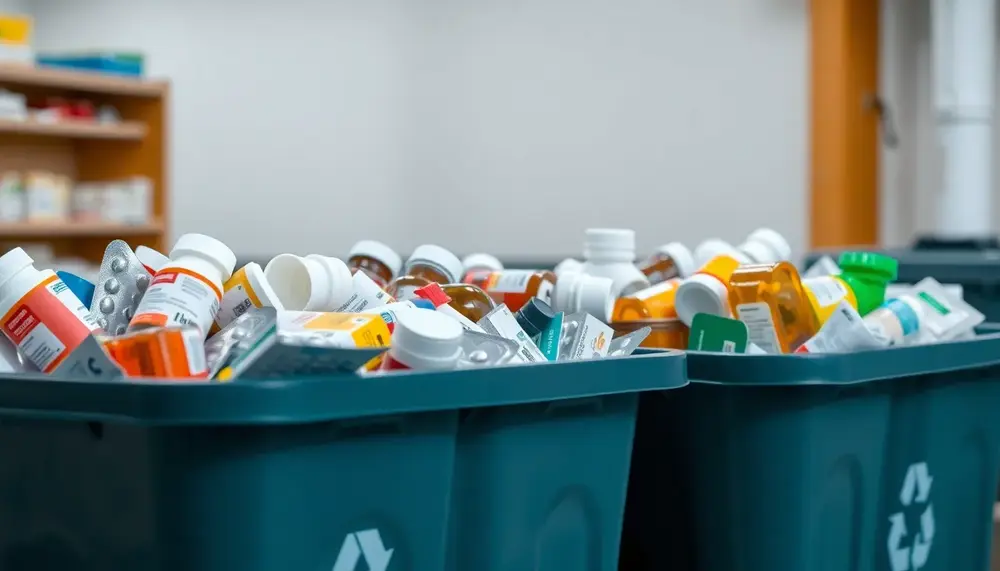Table of Contents:
Background: The Urgency of Sustainable Pharmaceutical Packaging
Pharmaceutical packaging is under a magnifying glass—rightly so, if you ask anyone tracking environmental impact. With the industry producing roughly 52 million tons of CO₂ emissions each year, packaging stands out as both a culprit and a potential hero. The urgency isn’t just about the sheer volume of waste or the mountain of single-use plastics piling up worldwide. It’s about the razor-sharp regulatory scrutiny, the relentless demand for product safety, and the public’s rising expectations for eco-friendly solutions—all converging at once.
What really raises the stakes? The sector’s packaging often uses complex, multi-layered materials that are tough to recycle and rarely make it back into the loop. Add to that: the global shift toward circular economies is pushing pharmaceutical companies to rethink not just what their packaging is made of, but how it can be collected, sorted, and reprocessed without compromising safety or efficacy. In many regions, new regulations are on the horizon, mandating higher recycling rates and stricter documentation of environmental performance. This isn’t a distant future scenario; it’s a live issue for every company in the field.
So, why does this matter right now? Because the old playbook—minimize, reuse, ignore—just doesn’t cut it anymore. Instead, the focus is on scalable recycling solutions that work within the unique constraints of pharma: absolute purity, traceability, and patient safety. The companies that crack this code will not only reduce their carbon footprint but also position themselves as trusted, future-ready partners in a world that demands more than just compliance. The clock is ticking, and the industry is feeling the heat—both from regulators and from the planet itself.
Cutting-Edge Recycling Technologies in Pharmaceutical Packaging
Innovative recycling technologies are shaking up pharmaceutical packaging, moving the industry far beyond basic sorting and shredding. These new approaches target the unique challenges of pharma—think purity, safety, and regulatory compliance—while unlocking real circularity. Here’s what’s making waves right now:
- Advanced Mechanical Recycling: Next-generation sorting systems now use AI-driven sensors and hyperspectral imaging to identify and separate even tiny or tricky pharmaceutical packaging components. This boosts the purity of recycled material, making it more suitable for sensitive applications.
- Chemical Recycling (Depolymerization): This process breaks down polymers like PET and polyolefins into their original monomers. The resulting feedstock can be re-polymerized into high-grade, pharma-ready plastics. Several pilot projects are underway to prove compliance with stringent pharma standards, and the first certified applications are on the horizon.
- Carbon Capture-Based Polymer Synthesis: Some innovators are using captured industrial CO2 emissions as a raw material for new plastics. These “carbon-negative” polymers can match the performance of conventional packaging, while dramatically reducing fossil resource use.
- Bio-Based and Compostable Materials: Packaging made from renewable feedstocks—like sugarcane, cellulose, or even agricultural waste—offers compostability and lower environmental impact. New barrier coatings and multilayer designs are making these materials viable for pharma, where protection and shelf life are non-negotiable.
- Smart Tracing and Digital Watermarking: Digital markers embedded in packaging materials enable automated, high-precision sorting and full traceability. This is a game-changer for ensuring that recycled content is safe for pharmaceutical reuse and for meeting regulatory documentation requirements.
Each of these technologies brings its own hurdles—cost, scale, regulatory acceptance—but together, they signal a radical shift. The future of pharmaceutical packaging recycling is not just about closing the loop; it’s about doing so with uncompromising safety and quality.
Pros and Cons of Recycling Solutions in Pharmaceutical Packaging
| Aspect | Pros | Cons |
|---|---|---|
| Advanced Mechanical Recycling | Improves purity of recycled materials, suitable for sensitive applications using AI and imaging for better sorting. | May require significant investment and may still struggle with complex or multi-material packaging. |
| Chemical Recycling (Depolymerization) | Can produce pharma-grade plastics by breaking down polymers to monomers; potential for high quality and true circularity. | Technology is still at pilot stage for pharma; high costs and regulatory hurdles persist. |
| Bio-Based & Compostable Materials | Uses renewable resources; lower environmental footprint and compostability possible; new coatings improve suitability. | Compostability requirements are strict; may need multilayers or coatings, complicating recycling; compatibility with existing collection is limited. |
| Closed-Loop PET Recycling | Ensures high purity, traceability, and reuse in pharma; reported reductions in carbon footprint up to 70%. | Requires dedicated collection and sorting infrastructure; only works well for specific formats (e.g. PET bottles). |
| Smart Tracing & Digital Watermarking | Enables precise automated sorting and full traceability; meets regulatory and safety documentation demands. | Relies on adoption of compatible technology across the supply chain; initial setup and standardization required. |
| Life Cycle & Safety Certification | Guarantees safety via rigorous testing, traceability, and third-party audits. | Resource-intensive; ongoing validation is required; slows down implementation speed for new solutions. |
Practical Criteria and Challenges for Recyclability in Pharma Packaging
Assessing the recyclability of pharmaceutical packaging is not a walk in the park—it’s a balancing act between technical feasibility, market realities, and uncompromising safety standards. Let’s break down the nuts and bolts of what really matters when you want your pharma packaging to be truly recyclable:
- Material Purity and Simplicity: Monomaterial structures (like pure PET or HDPE) are much more likely to be accepted by recycling facilities. Multi-layer films, metallic foils, or non-detachable components? They often doom the package to landfill, no matter how small the amount.
- Size and Form Factor: Tiny blister packs, sachets, or vials are notoriously difficult to collect and sort. If a package is too small for automated sorting lines, it’s likely to slip through the cracks—literally.
- Labeling and Inks: Labels that are easy to remove and use non-toxic, water-soluble inks help maintain the purity of recycled material. Permanent adhesives or metallic inks can contaminate recycling streams and reduce yield.
- Color and Opacity: Dark or opaque plastics are a headache for optical sorting systems. Clear or light-colored packaging is much more likely to be identified and properly recycled.
- Compatibility with Existing Infrastructure: Even the most eco-friendly material is useless if local recycling systems can’t process it. Designing for recyclability means knowing the realities of regional waste management capabilities.
- Market Demand for Recyclate: There needs to be a viable end market for the recycled material. If the recycled resin can’t be used in new pharma packaging or other high-value applications, the business case collapses.
In short, pharma packaging designers face a tricky puzzle: meet strict safety and performance specs, while ensuring the package can be efficiently recycled in the real world. It’s a tall order, but with the right design choices and an eye on evolving recycling technologies, it’s not out of reach.
Best Practice Example: Closed-Loop PET Recycling for Medicine Bottles
Closed-loop PET recycling for medicine bottles is setting a new benchmark in sustainable pharmaceutical packaging. Unlike traditional recycling, this approach keeps PET within the pharma sector, turning used bottles directly into new ones without downcycling into lower-grade products. Here’s how the process works and why it’s catching on:
- Strict Source Control: Only PET bottles from pharmaceutical use are collected, ensuring the feedstock is free from contamination by non-pharma materials. This targeted collection maintains the integrity needed for sensitive applications.
- Dedicated Cleaning and Decontamination: The bottles undergo advanced washing and super-cleaning steps, removing even trace pharmaceuticals, adhesives, and residues. This is vital for meeting the rigorous purity standards required for new medicine bottles.
- Traceability and Certification: Every batch of recycled PET is tracked from collection to final product, with full documentation for regulatory compliance. Independent third-party audits confirm that the recycled material meets all pharma-grade requirements.
- Performance Parity: The resulting rPET bottles match virgin PET in strength, clarity, and barrier properties—so there’s no compromise on product protection or shelf life.
- Real-World Implementation: Several leading pharmaceutical companies in Europe and North America have already launched closed-loop PET bottle systems, reporting up to 70% reduction in carbon footprint compared to conventional packaging.
This closed-loop model not only slashes environmental impact but also builds trust with regulators and patients by proving that recycled content can be safe, reliable, and fully traceable. It’s a powerful template for the future of sustainable pharma packaging.
Ensuring Safety and Certification in Recycled Pharma Packaging
Guaranteeing safety and achieving certification for recycled pharmaceutical packaging is a rigorous, multi-layered process—there’s simply no room for shortcuts. Every step is under the microscope, from the sourcing of recycled material to the final packaging that reaches patients. The stakes? Patient health, regulatory compliance, and brand trust.
- Migration Testing: All recycled packaging must undergo exhaustive migration studies to ensure that no harmful substances leach into medicines. These tests are tailored to the specific drug formulations and storage conditions, and they’re repeated for every new batch of recycled material.
- Batch Traceability: Full traceability systems are mandatory. Each lot of recycled resin is tracked through the entire supply chain, enabling rapid recalls if even a hint of contamination is detected. This digital paper trail is often required by authorities before market approval.
- Independent Auditing: Third-party laboratories and certification bodies regularly audit both recycling processes and finished packaging. Only after passing these independent checks can packaging earn critical certifications such as EU Pharmacopeia or FDA compliance.
- Continuous Process Validation: It’s not a one-and-done deal. Ongoing validation of recycling and packaging processes is needed to adapt to changes in raw material quality, regulatory updates, or new drug products. This dynamic approach keeps safety standards watertight.
- Life Cycle and Risk Assessments: Comprehensive life cycle analyses and risk assessments are conducted to document the environmental and health impacts of recycled packaging. These reports support transparent communication with regulators and stakeholders.
In essence, recycled pharma packaging must clear a much higher bar than standard consumer packaging. Only through relentless testing, documentation, and independent oversight can companies ensure that recycled solutions meet the uncompromising demands of the pharmaceutical world.
Optimizing Packaging Design for Maximum Recyclability
Designing pharmaceutical packaging for optimal recyclability is all about smart, forward-thinking choices at every stage of development. It’s not just about picking the right material—though that’s important—but about creating a package that fits seamlessly into existing recycling streams and meets evolving market needs.
- Eco-Design Principles: Early integration of recyclability into the design process is key. This means involving recycling experts from the outset and using digital simulation tools to predict how packaging will behave in real-world recycling systems.
- Minimalist Component Strategy: Reducing the number of packaging elements—caps, inserts, seals—simplifies disassembly and sorting. Where multiple parts are unavoidable, using snap-fit or easy-peel connections (instead of adhesives) makes separation much easier.
- Standardization Across Product Lines: Harmonizing packaging formats and materials across different medicines can boost recycling rates and lower costs. Standardized designs are more attractive to recyclers and help build a consistent supply of high-quality recyclate.
- Dynamic Labeling Solutions: Removable or water-soluble labels, along with direct printing technologies, reduce contamination risk and speed up processing in recycling facilities. Labels can also include digital markers to support smart sorting.
- Feedback Loops with Recyclers: Establishing ongoing dialogue with recycling companies ensures that design tweaks actually translate into better recyclability on the ground. Real-world feedback can drive continuous improvement and innovation.
By embedding these strategies into the design workflow, pharmaceutical companies can future-proof their packaging—making it both sustainable and ready for tomorrow’s regulatory and market demands.
Future Outlook: Next-Generation Solutions for Sustainable Pharmaceutical Packaging
The next wave of sustainable pharmaceutical packaging is already taking shape, and it’s more ambitious than anything seen before. Emerging solutions are not just tweaking old systems—they’re reimagining the entire lifecycle of packaging, from molecular design to end-of-life recovery. Here’s what’s on the horizon:
- Enzyme-Driven Polymer Degradation: New research is focusing on engineered enzymes that can selectively break down complex polymers at low temperatures. This technology could enable on-site recycling for hospitals and pharmacies, dramatically reducing transportation emissions and costs.
- Blockchain-Enabled Traceability: Secure, decentralized tracking systems are being piloted to monitor recycled content and packaging journeys in real time. This promises tamper-proof verification of sustainability claims and compliance with evolving global regulations.
- Smart Packaging with Embedded Sensors: Next-gen pharma packaging may feature integrated sensors that monitor temperature, humidity, or tampering. At end-of-life, these sensors could trigger sorting systems or even signal when a package is ready for recycling, streamlining collection and processing.
- Solvent-Based Recycling for Multilayer Materials: Innovative solvent processes are being developed to separate and purify layers in complex packaging, allowing high-value recovery of both plastics and aluminum. This could finally unlock recyclability for formats previously considered “unrecyclable.”
- Collaborative Industry Platforms: Pharma companies are joining forces with material scientists, recyclers, and regulators to co-develop standards and infrastructure. These alliances aim to accelerate adoption of breakthrough technologies and harmonize sustainability metrics across markets.
As these solutions mature, the pharmaceutical sector is poised to leap from incremental improvements to transformative change—delivering packaging that’s not just safer and greener, but smarter and fully integrated into a truly circular economy.
Key Takeaways: Making Sustainable Choices in Pharma Packaging
Key takeaways for making sustainable choices in pharmaceutical packaging require a shift in mindset, ongoing vigilance, and a willingness to embrace innovation beyond the obvious.
- Holistic Evaluation: Assess packaging sustainability by considering the entire value chain—from raw material sourcing to post-consumer recovery—rather than focusing on a single attribute like recyclability.
- Supplier Engagement: Build long-term partnerships with suppliers who demonstrate transparency in their own sustainability practices and can provide documentation for recycled or bio-based content.
- Scenario Planning: Regularly conduct scenario analyses to anticipate regulatory shifts, raw material shortages, or sudden changes in recycling infrastructure. This proactive approach reduces risk and supports resilient packaging strategies.
- Consumer Education: Develop clear, actionable communication for end-users—such as pharmacists and patients—on how to dispose of or return packaging, maximizing collection rates and minimizing contamination.
- Data-Driven Decision Making: Use digital tools and real-time data to monitor environmental impacts, trace material flows, and optimize packaging design iteratively based on measurable outcomes.
Ultimately, sustainable pharma packaging is not a one-time project but an evolving commitment—demanding agility, transparency, and a willingness to challenge the status quo at every turn.
Frequently Asked Questions on Recycling Innovations in Pharma Packaging
What are the main recycling technologies used for pharmaceutical packaging?
Key recycling technologies in pharmaceutical packaging include advanced mechanical recycling with AI-driven sorting, chemical recycling (depolymerization), carbon capture-based polymer synthesis, and bio-based or compostable materials. Each technology is designed to address strict purity and safety requirements unique to the pharma sector.
Why is recyclability especially challenging for pharmaceutical packaging?
Pharmaceutical packaging often uses complex, multi-layered materials for product safety and shelf life, making sorting and recycling difficult. Small formats, challenging label adhesives, and strict regulatory requirements for patient safety further complicate recyclability compared to other sectors.
How is the safety of recycled pharmaceutical packaging guaranteed?
Safety is ensured through exhaustive migration testing, full batch traceability, independent third-party auditing, and ongoing validation of all recycling and production processes. This multi-layered approach ensures that recycled packaging meets strict regulatory and patient safety standards.
What design strategies boost recyclability in pharma packaging?
Effective strategies include selecting monomaterial structures, minimizing package components, using removable or water-soluble labels, and considering color and size for easier sorting. Close collaboration with recyclers during the design phase helps tailor packaging for real-world recycling systems.
Which new trends are shaping the future of pharmaceutical packaging recycling?
Emerging trends include enzyme-driven polymer degradation, blockchain-enabled traceability, smart packaging with embedded sensors, innovative solvent-based recycling for multilayer materials, and collaborative industry platforms to standardize sustainability practices.






